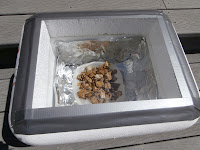I needed a melter to process the beeswax. There are well-constructed,
fancy ones available, but I found
this on YouTube and decided to make one like hers.
First, I needed a styrofoam cooler. Every once in a while, I would stop by a garage sale to look for one. I had been expecting that cheap coolers would soon be in the stores for summer. However, last week at work, we received some medicine that needed to be cold. It was in a thick styrofoam box with cold packs. One of the nurses, who knew I wanted to make a melter, asked me if I wanted it the box. Natch.
Next, I needed glass. I had one pane for a long time, but it got broken when
Jesus Chavez's crew was cleaning the yard. I was going to go to Orchard for the glass, when Maidi suggested I use the glass from an old
collage frame. So, down to Ace for a
glass cutter and
glass breaking pliers. It worked quite well and now I had two panes of glass.


Using a steak knife, I cut a rectangle out of the lid. I glued one pane of glass inside and duct taped the other to the outside. I had to cut away two shelves from inside using my
keyhole saw.
I lined the box with tin foil, put some water in a plastic tube and placed my
paint straining bag around it, holding it taut with a clothes pin- so hi tech.

I put a bunch of wax on the cloth, put the lid on and waited, impatiently. In not too long, I could see the wax starting to melt. Then there were drops of was visible in the water. Ultimately, I may have waited too long as the water was boiling and the residue on the bag was pretty cooked.
 |
| After 40 minutes |
 |
| After one hour |
 |
| After 4 hours. Melted wax on boiling water |
As soon as I took the lid off, there was a strong smell of wax and two bees came over to investigate. It was a little tricky to get the wax into the house simultaneously keeping the bees outside. I put the wax in the fridge to cool.
 |
| My first (somewhat) purified bees wax |
There was a little debris in the wax, but it the process worked. Now I need a bigger tub and either a larger bag or an old pair of pantyhose.















